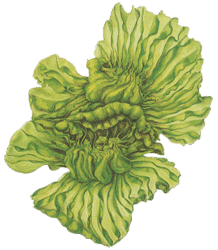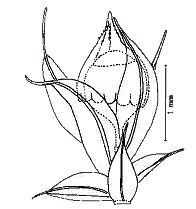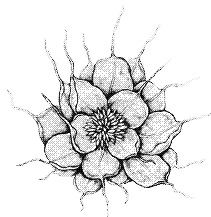|
Episodes in Australian Bryology - the 1890s and later
Handbooks of the later 20th century
For much of the 20th century one of the major obstacles to the wider study of Australian bryophytes has been the lack of easily accessible literature. The information that had been published was generally scattered in Australian or overseas scientific journals. Trying to find the relevant papers from journals can be both time consuming and frustrating. It is much easier if someone has gone to the effort of putting all the useful information into a more easily accessible book. This section will look largely at the contributions of three people: David Catcheside, Ilma Stone and George Scott. Like many other bryologists of the later 20th century these three made fundamental contributions to the knowledge of Australian bryophytes through the publication of numerous scientific papers but they also wrote the first modern guide books to the bryophytes of Australia.
As well as being exceedingly useful to professional bryologists, these books helped make bryophytes accessible to a wider audience. It is a commonly observed fact that the publication of a guide book about some group of poorly understood organisms will generate wider interest in those organisms. The books published by the three bryologists made it easier for people such as non-bryological botanists, ecologists and amateur natural historians to identify the bryophytes they found. As well as including information contained in previously published papers the books included new details, based on the examination of many additional herbarium specimens and not yet published. Finally, the information in the books was based on the study of Australian specimens. Many species found in Australia are also found overseas. In any given species there will always be some variation from place to place – just think of the variation you can see in humans. When writing a book about the bryophytes of Australia it is essential to give descriptions based on Australian specimens, even for a species common in other parts of the world. In this way it's possible to see if and how the Australian examples of that species differ from those from other countries.
|
David Guthrie Catcheside (1907-1994) was an amateur bryologist, but a very competent and knowledgeable one. He had had an interest in bryophytes from a young age in the United Kingdom but, by profession, was a geneticist. He was the first director of the Research School of Biological Sciences at the Australian National University in Canberra. Following his move to South Australia after his retirement he completed his major work, the book Mosses of South Australia, which was published in 1980. The bulk of the book is devoted to species' descriptions. There is also an informative chapter on structural features, reproduction and life cycle, ecology, cytology and a guide to the collecting and study of mosses (with notes about microscopical technique). Some of the species names he used have been superseded but the drawings and detailed species' descriptions make this still a very useful volume, especially for the identification of the mosses of arid Australia – both in and beyond South Australia. He had hoped to produce a corresponding handbook of the liverworts of South Australia. His collection of bryophyte specimens, microscope slides and manuscript notes is held by the State Herbarium in Adelaide![]() .
.
Ilma Grace Stone, née Balfe, (1913-2001) obtained a Master of Science degree from the University of Melbourne at the age of 20, after which she married Alan Stone, a civil engineer and "did no botany" for 20 years. The story of her return to botany, in 1957, was told in an obituary:
One day she was listening to the radio as she ironed the shirts and blouses (with 3 children and a husband that was 20 shirts a week). She heard an appeal from the Chemistry Department of the University of Melbourne for demonstrators for their lab classes. When Alan came home from work she mused how wonderful it would be if it were the Botany department that wanted demonstrators. Alan encouraged her to telephone them and ask. Miraculously Botany could use more demonstrators, and had the sense to invite her in – a wonderful career was resumed – as a teacher and researcher, first with ferns, and subsequently with mosses.
Thus it was that she published her first bryological paper at the age of 48 and from 1969 her research work was concentrated on mosses. She published over 70 research papers, 11 after the age of 80. She was renowned as a meticulous observer, both in the field and at the microscope. Her ability to find the tiniest of mosses in the field was legendary and she wrote extensively about such species. The comment by the eminent Australian bryologist Helen Ramsay that, in Stone's view"..any specimen bigger than a few millimetres was not considered nearly so interesting..." may be an exaggeration – but a slight one at most! Ilma Stone's dislike of the cold led her and her husband to take an annual winter holiday in north Queensland. Never one to sit idle for too long, she would look for interesting mosses and so added much to the knowledge about the bryophytes of Queensland. She has collected bryophytes in various out-of-the-way places but at other times the collecting localities were rather mundane. In 1983 she published the first description of the new moss species Fissidens gymnocarpus, based on specimens collected at Cooktown "...in a motel yard on loose soil at edge of a shaded concrete slab subject to water runoff...", a clear illustration of the fact that her eyes were always on the lookout for potentially interesting specimens. Her many thousand collections are now held by the herbarium at the Royal Botanic Gardens in Melbourne![]() .
.
The 29th issue of the Australasian Bryologcial Newsletter, published in December 1993, marked Ilma Stone's 80th birthday by publishing various reminiscences about her – including one by Helen Ramsay.
|
George Anderson Macdonald Scott (1933-1998) was born in Scotland, moved to New Zealand in 1960 and to Australia in 1970. He had been interested in bryophytes during his student days and during his time in New Zealand this interest deepened. The move to Australia saw him take up the study of Australian bryophytes and he did much to re-vitalize the study of bryophytes in Australia. Between 1979 and 1985 he ran an annual 5-day bryophyte course at Monash University in Melbourne. This was open to all – young or old, experienced or inexperienced – and introduced many amateur and professional botanists to bryophyte taxonomy and ecology. As well as taxonomic papers, Scott published various ecological studies. His earlier work in the United Kingdom had been in plant ecology. He also made use of his knowledge of Greek and Latin to publish on the early European understanding of mosses, from classical times to 1500. He co-authored The Mosses of Southern Australia with Ilma Stone and the book was published in 1976. It contained numerous superb black-and-white illustrations, and a colour frontispiece ![]() , by the renowned Australian botanical artist, Celia Rosser. In the opening sentences of the introduction the authors wrote:
, by the renowned Australian botanical artist, Celia Rosser. In the opening sentences of the introduction the authors wrote:
The resolute botanist, faced with identifying Australian mosses, has hitherto had little encouragement. For texts and illustrations he has had to rely on handbooks of New Zealand, South African and British mosses, supplemented by a wide range of papers, mostly out of date and hard to obtain; workable keys he has had to do without. It is not surprising that so few have felt it worthwhile to persist. For tropical Australia this is still the case, but we hope that this book will make the richness of the temperate moss flora much more easily accessible to both amateur and professional botanists, and bring to others the joy and excitement of working with these fascinating and challenging plants.
This was both an accurate summary of the difficulties faced by people who wished to identify moss collections and also a statement of the limitations of the book. By and large, bryologists resident in Australia have lived and worked in the temperate south-east of the country and so the bryophytes of the south-east have been better documented than those of other areas.
A second book, Southern Australian Liverworts, written by Scott, with illustrations and assistance by Bruce Fuhrer and Rod Seppelt, was published in 1985. The aim was similar to that of the moss book, namely the production of a readily available identification manual. In the preface Scott noted that the book was "...a first and not a final flora...", realizing that there were still considerable gaps in knowledge of Australian liverworts. He began the book's introduction with the following sentences, which convey sentiments similar to those in the above extract from the moss book:
The liverworts (Hepaticae) are a group of plants with which Australia is unusually well provided, but for which the means of identification have been sufficiently esoteric to daunt all but the specialist. This book attempts to bring the identification of the Victorian liverwort flora within reach of students and naturalists, and should also be largely, although not completely, effective over most of the rest of southern Australia with the exception of Tasmania. The Tasmanian flora is much richer than that of Victoria in temperate species, as is the northern part of New South Wales in subtropical species. These are the regions where the practical usefulness of this account will diminish
.
In addition to these works and many scientific papers about Australian bryophytes, the later 20th century also saw the appearance of modern catalogues of Australian bryophytes, with bibliographies of the relevant literature. Such publications, though rather dry in content, are very useful to anybody trying to track down information about Australian bryophytes. The first modern liverwort and hornwort catalogue appeared as the paper "Australian liverworts (Hepaticae): annotated list of binomials and check-list of published species with bibliography". It was compiled by George Scott and JA Bradshaw and constituted the entire January 1986 issue of the Australian botanical journal Brunonia. The moss equivalent: Catalogue of mosses of Australia and its external territories, by the late Heinar Streimann and Judith Curnow appeared in 1989 and was published as a book by the Australian Biological resources Study (ABRS). ABRS has published later versions of the catalogues, as well as several other books dealing with Australian bryophytes and with more due to appear. You can find out more from this page on the ABRS website.
Scott and Stone and the University of Melbourne herbarium
The specimens amassed by Scott and Stone constitute a significant collection of bryophytes from many parts of Australia, are an important resource for research into Australia's bryophytes and are held at the University of Melbourne herbarium. An article titled 'Mosses, liverworts and hornworts: Significant bryophyte collections at the University of Melbourne Herbarium', written by Gillian Brown the curator of the herbarium, appeared in University of Melbourne Collections, Issue 8, June 2011 (link) and deals with the university herbarium's bryophyte collections as well as giving some biographical information about Scott, Stone and another collector, Harold Breidahl. The University of Melbourne has kindly permitted the reproduction of that article here. The university library publishes research about the various collections owned by the university and general information about such research can be found here.
![An Australian Government Initiative [logo]](/images/austgovt_brown_90px.gif)





